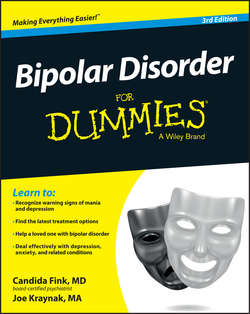Читать книгу Bipolar Disorder For Dummies - Joe Kraynak - Страница 5
На сайте Литреса книга снята с продажи.
Part I
Getting Started on Your Bipolar Journey
Chapter 1
Grasping Bipolar Disorder: Symptoms and Diagnosis
Cracking Open the Diagnostic Manual: DSM-5
ОглавлениеWhen a doctor in the United States diagnoses a mental illness, such as bipolar disorder, she turns to the American Psychiatric Association’s (APA) Diagnostic and Statistical Manual of Mental Disorders (DSM) for guidance. This manual defines numerous patterns of symptoms and illnesses that are supported by scientific research and a consensus among a wide variety of experts. During the writing of this book, the APA recommends using DSM-5, the fifth edition, which was published in May 2013. Don’t be surprised if you see references to earlier editions, particularly DSM-IV, the fourth edition.
Throughout this chapter, we describe the symptoms of bipolar disorder according to the diagnostic criteria presented in DSM-5. Although the fundamental criteria haven’t changed all that much from DSM-IV to DSM-5, some of the language has been modified and criteria have been added to help doctors arrive at and describe a person’s condition more fully.
Diagnosis isn’t a simple matter of matching a list of symptoms to a label. Doctors are expected to use the DSM along with their training, clinical experience, and professional judgment to arrive at the correct diagnosis.
The International Classification of Diseases (ICD)
Doctors in countries throughout the world (not the United States) rely on the World Health Organization’s (WHO) International Classification of Diseases, a classification system for all health issues. Chapter V of the ICD specifically addresses mental and behavioral disorders.
The major difference between DSM-5 and ICD-10 is that the WHO manual doesn’t use the labels bipolar I and bipolar II as primary distinctions. Instead, ICD-10 refers to the disorder as bipolar affective disorder and then further classifies it by the nature of the current episode: currently hypomanic, currently manic, currently depressed, mixed disorder, or in remission. In addition, the ICD-10 requires two or more mood episodes, with at least one being manic or hypomanic, to qualify for a bipolar diagnosis, while the DSM requires only a single manic or hypomanic episode.
The APA and WHO work together closely to coordinate their efforts. So in clinical practice, a doctor using one manual should arrive at a similar diagnosis as a doctor using the other.
